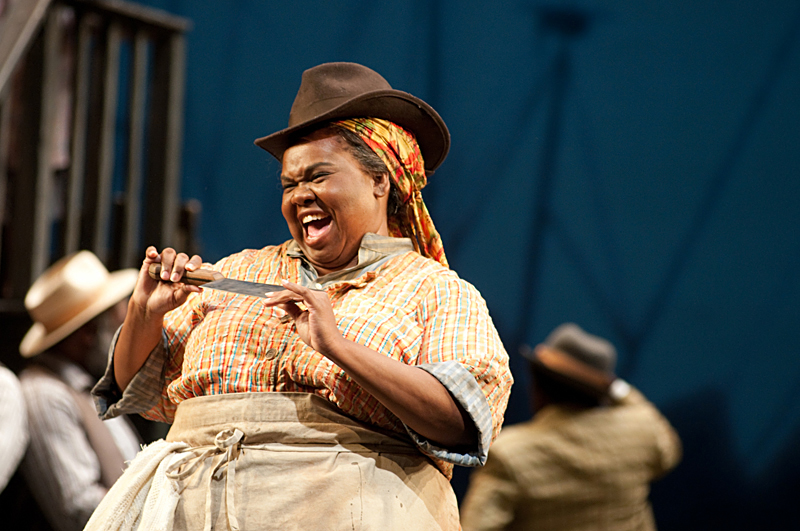George Gershwin had a successful Broadway career behind him when he tackled Porgy and Bess, and he put everything he’d learned about stagecraft into his tale of a troubled woman and the three men in her life in the coastal South Carolina neighborhood of Catfish Row: Porgy, the gentle outcast she loves; Crown, the charismatic thug she’s drawn to; and Sportin’ Life, the drug pusher she ends up with. And when you see Seattle Opera’s richly gripping production, which opened Saturday, you may start asking yourself which of Gershwin’s predecessors among musical dramatists honestly surpassed him in the creation of living, breathing, bleeding people. As three-dimensional personalities, knowable, memorable, and powerful, these two title characters rank with Figaro (either one), Violetta, Carmen, Rodolfo and Mimì, Brünnhilde—name your favorites.
Furthermore, what other opera offers such a wealth of equally telling smaller roles: characters who enter the spotlight for three minutes—or, in the Strawberry Woman’s case, a mere eight or so lines—and put the show in their pocket? Ibidunni Ojikutu comes onstage with her fruit basket and one tiny arietta and holds the audience rapt. Angel Blue, as Clara, pulls off the daunting task of launching the show and setting the scene with its most famous number, the lullaby “Summertime.” And Gwendolyn Brown, as Maria, Catfish Row’s mater familias, goes off like a rocket at Sportin’ Life when he starts peddling his “happy dust.” Above all, there’s the widow Serena and her two showstoppers. The shattering rawness Mary Elizabeth Williams brings to the funeral lament “My Man’s Gone Now” is like nothing else I’ve seen in McCaw Hall, and she trumps it later in a prayer scene, a soaring gospel aria that nearly converted me.
Such vivid individuality is how Gershwin (and librettists Ira Gershwin and DuBose Heyward) saved their characters from stereotype. One strategy was to imbue them with a balance of positive and negative traits in a way that feels true-to-life. Serena is nurturing yet fiercely judgmental; I kept thinking back to Williams’ memorable turn, a decade ago in a Seattle Opera Young Artists performance, as Don Giovanni‘s curiously similar Donna Elvira, an implacable moralizer with a deep and exposed vein of pathos. Michael Redding is electric as Crown—brutal yet courageous, as ready to kill in anger, crash the funeral, and blaspheme swaggeringly as he is to brave a hurricane in a rescue attempt. Jermaine Smith’s Sportin’ Life is predatory and amoral yet full of joie de vivre, a song-and-dance viper.
Striving for nobility yet all too tragically susceptible, Bess makes a fascinating antiheroine, and Lisa Daltirus is fearless in showing her weaknesses even at the expense of our sympathy. As Sportin’ Life begins to seduce her back into her wanton ways, you can practically feel the audience deflate, as if a collective thought bubble were popping up overhead: “Nooooooo . . . ” Mostly passive, a reactor rather than an actor, Porgy is a challenging role, especially surrounded by all these blazing personalities; Gordon Hawkins’ effective approach is to give him a sort of glowering earthiness.
For all the 1935 opera’s picturesqueness, the hymns and crap games and Sunday-best picnics, this isn’t a tourist excursion to a quaint Old South theme park. There’s overt coke-sniffing, a couple of startlingly violent fight scenes, and Crown’s more-or-less rape (depending on how much consent you think is involved) of Bess. Likable characters die, and the lovers aren’t paired off at the final curtain. But there’s comic relief, too; it’s amazing what the creators were able to pack into this piece—brief as operas go—without making it feel rushed or contrived. (In this performance, the two acts run 90 and 60 minutes.) They give not only their characters but also the audience room to breathe, to soak in the life of Catfish Row, and the tragedy packs all the more punch for it.







